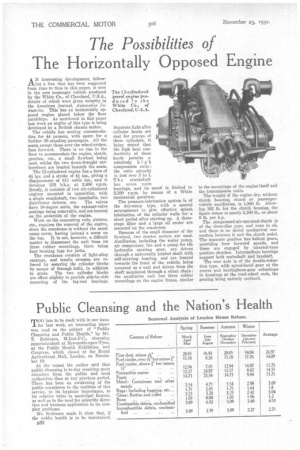The Possibilities of The Horizontally Opposed Engine
Page 48

If you've noticed an error in this article please click here to report it so we can fix it.
A N interesting development, following a line that has been suggested from time to time in this paper, is seen in the new passenger vehicle produced by the White Co., of Cleveland, U.S.A., details of which were given recently in the American journal, Automotive Induzfries. This has an horizontally opposed engine placed below the floor amidships. As mentioned in this paper last week an engine of this type is being developed by a British chassis maker.
The vehicle has seating accommodation for 44 persons, with space for a further 56 standing passengers. All the seats, except those over the wheel-arches, face forward. There is no rise in the floor to accommodate the engine, clutch, gearbox, etc., a small flywheel being used, whilst the two down-draught carburetters are located beneath the seats.
The 12-cylindered engine fins a bore of 41 ins, and a stroke of 4-i ins., giving a displacement of 811 cubic ins., and it develops 225 b.h.p. at 2,400 r.p.m. Briefly, it consists of two six-cylindered engines mounted in opposition, with a single crankshaft, two camshafts, two distributor drivers, etc. The valves have 30-degree seats, the exhaust-valve seatings being removable, and are located on the underside of the engine.
Work on the connecting rods, pistons, etc., requires the removal of the engine, since the crankcase is without the usual sump cover, having instead a cover on the top. It is not, however, a difficult matter to disconnect the unit from its three rubber mountings, there being four locating lugs for jacks.
The crankcase consista of light-alloy castings, and tensile stresses are relieved by securing the cylinder blocks by means of through bolts, in addition to studs. The two cylinder blocks are offset slightly to provide side-by-side mounting of the big-end bearings.
Separate light-alloy cylinder heads are cast for groups of three cylinders, it being stated that the high heat conductivity of these heads permits .a relatively h i g Ii compression ratio ; the ratio actually is just over 5 to 1. T h e crankshaft has seven main bearings, and its speed 2,100 r.p.m. by means mechanical governor.
The pressure-lubrication system is of the dry-sump type, with a special arrangement to give effective splash lubrication of the cylinder walls for a short period after starting up. A threestage filter and a large oil cooler are mounted on the crankcase.
Because of the small diameter of the flywheel, two starter motors are used. Auxiliaries, including the water pump, air compressor, fan and a pump for fife hydraulic steering gear, are driven through a universally jointed shaft with self-centring bearing, and are located towards the front of the vehicle, being mounted as a unit and driven from the shaft mentioned through a agent chain; the auxiliaries unit has three rubber mountings on the engine frame, similar to the mountings of the engine itself and the transmission units.
The weight of the engine dry, without clutch housing, clutch or passengervehicle auxiliaries, is 1,860 lb. Allowing 192 lb. for the clutch housing, the figure comes to nearly 2,100 lb., or about 9 lb. per h.p.
The compressed-air-operated-clutch is of the three-disc type, and runs in oil, and there is no direct mechanical connection between it and the clutch pedal. The separate gearbox has helical gears, providing four forward speeds, and these are engaged by internal-type positive clutches. Intermediate bearings support both mainshaft and layshaft.
The rear axle is of the double-reduction type, with spiral-bevel gear at the centre and herringbone-gear reductions in housings at the road-wheel ends, the gearing being entirely enclosed.




































































































